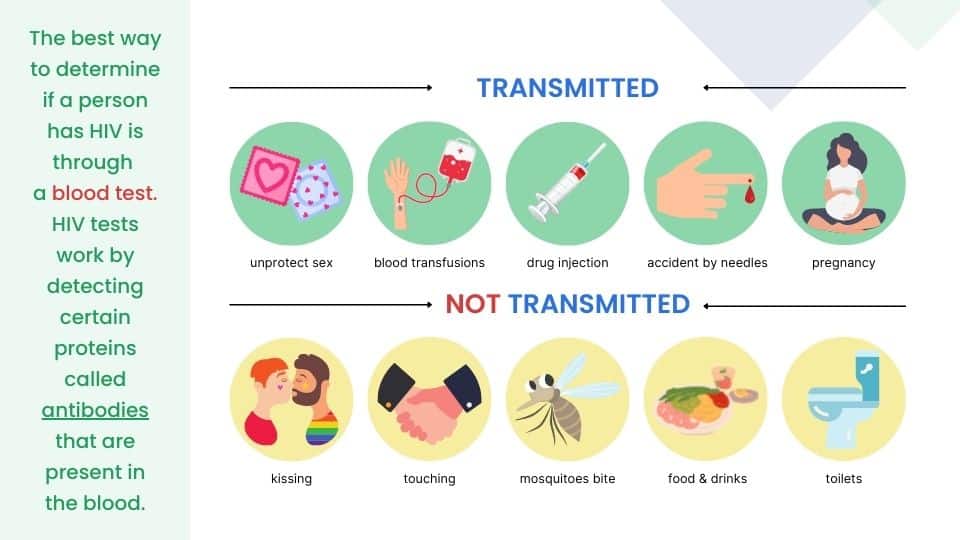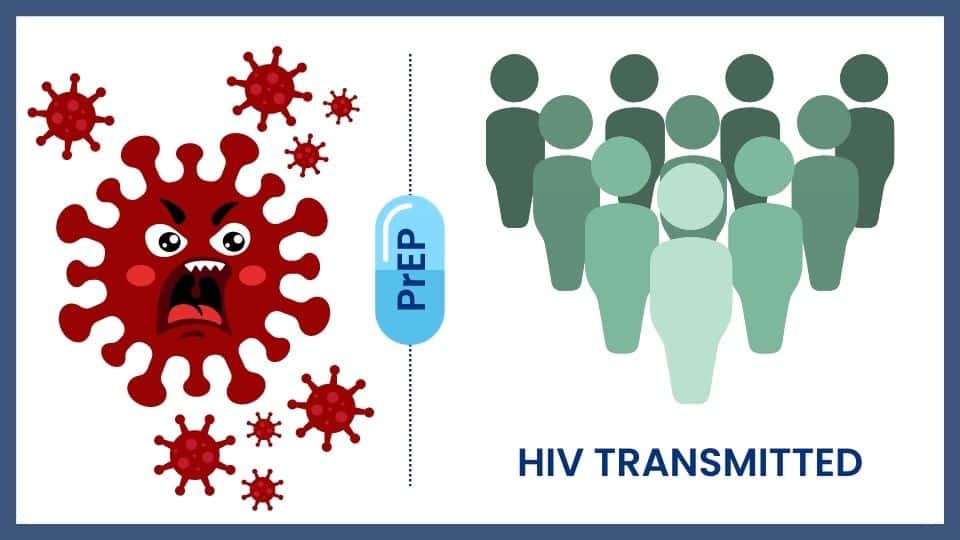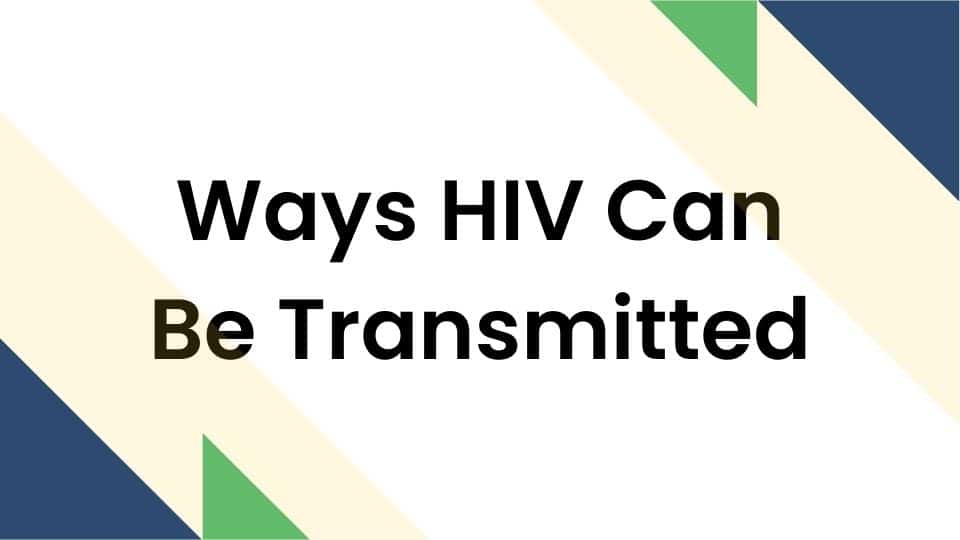You can only get HIV by coming into direct contact with certain body fluids from a person with HIV who has a detectable viral load. These fluids are:
- Blood
- Semen (cum) and pre-seminal fluid
- Rectal fluids
- Vaginal fluids
- Breast milk
For transmission to occur, the HIV in these fluids must get into the bloodstream of an HIV-negative person through a mucous membrane (found in the rectum, vagina, mouth, or tip of the penis); open cuts or sores; or by direct injection.
People with HIV who take HIV medicine daily as prescribed and get and keep an undetectable viral load have effectively no risk of sexually transmitting HIV to their HIV-negative partners. You can get HIV if you have anal sex with someone who has HIV without using protection (like condoms or medicine to treat or prevent HIV).
The best way to determine if a person has HIV is through a blood test.

How Is HIV Spread from Person to Person?
You can get HIV if you have anal sex
with someone who has HIV without using protection. Like condoms or medicine to treat or prevent HIV.
- Anal sex is the riskiest type of sex for getting or transmitting HIV.
- Being the receptive partner (bottom) is riskier than being the insertive partner (top).
- The bottom’s risk is higher because the rectum’s lining is thin and may allow HIV to enter the body during anal sex.
- The top is also at risk. HIV can enter the body through the opening at the tip of the penis (urethra); the foreskin if the penis isn’t circumcised; or small cuts, scratches, or open sores anywhere on the penis.
You can get HIV if you have vaginal sex
with someone who has HIV without using protection. Like condoms or medicine to treat or prevent HIV.
- Vaginal sex is less risky for getting HIV than receptive anal sex.
- Either partner can get HIV during vaginal sex.
- HIV can enter a person’s body during vaginal sex through the delicate tissue that lines the vagina and cervix.
- Vaginal fluid and blood can carry HIV, which can pass through the opening at the tip of the penis (urethra); the foreskin if the penis isn’t circumcised; or small cuts, scratches, or open sores anywhere on the penis.
Ways HIV can be transmitted from a mother to her baby during pregnancy, birth, or breastfeeding.
However, it is less common because of advances in HIV prevention and treatment.
- This is called perinatal transmission or mother-to-child transmission.
- Mother-to-child transmission is the most common way that children get HIV.
- Recommendations to test all pregnant women for HIV and start HIV treatment immediately have lowered the number of babies who are born with HIV.
- If a woman with HIV takes HIV medicine as prescribed throughout pregnancy and childbirth, and gives HIV medicine to her baby for 4 to 6 weeks after birth, the risk of transmission can be less than 1%.
You are at high risk for getting HIV if you share needles, syringes,
or other drug injection equipment (for example, cookers) with someone who has HIV. Never share needles or other equipment to inject drugs, hormones, steroids, or silicone.
- Used needles, syringes, and other injection equipment may have someone else’s blood on them, and blood can carry HIV.
- People who inject drugs are also at risk for getting HIV (and other sexually transmitted diseases) if they engage in risky sexual behaviors like having sex without protection (such as condoms or medicine to prevent or treat HIV).
- Sharing needles, syringes, or other injection equipment increases your risk for getting hepatitis B and hepatitis C, and other infections.
Ways HIV is spread only in extremely rare cases by:
Oral Sex
Oral sex involves putting the mouth on the penis (fellatio), vagina or vulva (cunnilingus), or anus (rimming).
- Factors that may affect the risk of getting HIV include:
- Ejaculation in the mouth with oral ulcers, bleeding gums, or genital sores.
- The presence of other sexually transmitted diseases (STDs).
- You can get other STDs from oral sex. If you get feces in your mouth during anilingus, you can get hepatitis A and hepatitis B, parasites like Giardia, and bacteria like Shigella, Salmonella, Campylobacter, and E. coli.
Workplace
- The most likely cause is injury with a contaminated needle or another sharp object.
- Careful practice of standard precautions protects patients and health care personnel from possible occupational HIV transmission.
Medical Care
- The blood supply and donated organs and tissues are thoroughly tested. It is very unlikely that you would get HIV from blood transfusions, blood products, or organ and tissue transplants.
- You can not get HIV from donating blood. Blood collection procedures are highly regulated and safe.

Food Contamination
- The only known cases are among infants. Contamination occurs when blood from a caregiver’s mouth mixes with pre-chewed food and an infant eats it.
- You can’t get HIV from consuming food handled by someone with HIV.
Biting and Spitting
- The small number of documented cases have involved severe trauma with extensive tissue damage and the presence of blood. This rare transmission can occur through contact between broken skin, wounds, or mucous membranes and blood or body fluids from a person who has HIV.
- There is no risk of transmission through unbroken skin.
- There are no documented cases of HIV being transmitted through spitting as HIV is not transmitted through saliva.
Deep, Open-Mouth Kissing
- Very rarely, transmission has occurred if both partners have sores or bleeding gums.
- You can’t transmit HIV through closed-mouth or “social” kissing with someone who has HIV.
- You can’t transmit HIV through saliva.
Touching
- Touching involves putting your hands, other body parts, or sex toys on your partner’s vagina, penis, or anus.
- The only possible risk would be if body fluids from a person with HIV touch the mucous membranes or damaged tissue of someone without HIV. Mucous membranes are found inside the rectum, vagina, opening of the penis, and mouth. Damaged tissue could include cuts, sores, or open wounds.
- You can get or transmit some other STDs (like human papillomavirus or HPV, genital herpes, and syphilis) through skin-to-skin contact.
- If you touch someone’s anus and get feces on your hands or fingers, you can also get or transmit hepatitis A and hepatitis B. Infection with parasites like Giardia and bacteria like Shigella, Salmonella, Campylobacter, and E. coli can also occur.
Tattoos and Body Piercings
- There are no known cases in the United States of anyone getting HIV this way.
- It is possible to get HIV from tattooing or body piercing if the equipment or ink has someone else’s blood in it. This is more likely to happen when the person doing the procedure is unlicensed because they may use unsterilized needles or ink.
- If you get a tattoo or a body piercing, be sure that the person doing the procedure is properly licensed and uses only new or sterilized equipment.

How is Ways HIV not transmitted?
- Air or water
- Biting insects such as mosquitoes, ticks or other insects
- Saliva, tears, or sweat that is not mixed with the blood of a person with HIV
- Shaking hands; hugging; sharing toilets; sharing dishes, silverware, or drinking glasses; or engaging in closed-mouth or “social” kissing with a person with HIV
- Drinking fountains
- Other sexual activities that don’t involve the exchange of body fluids (for example, touching).
- Casual contact, such as sharing food utensils, towels, and bedding
- Swimming in the same pool
- Using the same toilet seats
- Telephones
- HIV can’t be passed through healthy, unbroken skin.
References
Ways HIV Can Be Transmitted
- cdc.gov/hiv/basics/hiv-transmission/ways-people-get-hiv.html
How Do You Get or Transmit HIV?
- hiv.gov/hiv-basics/overview/about-hiv-and-aids/how-is-hiv-transmitted
How is HIV transmitted?
- nichd.nih.gov/health/topics/hiv/conditioninfo/transmission

